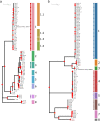Genomic epidemiology of Mycobacterium abscessus in a Canadian cystic fibrosis centre
- PMID: 36167715
- PMCID: PMC9514693
- DOI: 10.1038/s41598-022-19666-8
Genomic epidemiology of Mycobacterium abscessus in a Canadian cystic fibrosis centre
Abstract
The Mycobacterium abscessus complex causes significant morbidity and mortality among patients with Cystic Fibrosis (CF). It has been hypothesized that these organisms are transmitted from patient to patient based on genomics. However, few studies incorporate epidemiologic data to confirm this hypothesis. We longitudinally sampled 27 CF and 7 non-CF patients attending a metropolitan hospital in Ontario, Canada from 2013 to 2018. Whole genome sequencing along with epidemiological data was used to evaluate the likelihood of transmission. Overall, the genetic diversity of M. abscessus was large, with a median pairwise distance (IQR) of 1,279 (143-134) SNVs between all Ontario M. abscessus isolates and 2,908 (21-3,204) single nucleotide variants (SNVs) between M. massiliense isolates. This reflects the global diversity of this pathogen, with Ontario isolates widely dispersed throughout global phylogenetic trees of each subspecies. Using a maximum distance of 25 SNVs as a threshold to identify possible transmission, we identified 23 (of 276 total) pairs of closely-related isolates. However, transmission was probable for only one pair based on both genomic and epidemiological data. This suggests that person-to-person transmission of M. abscessus among CF patients is indeed rare and reinforces the critical importance of epidemiological data for inferences of transmission.
© 2022. The Author(s).
Conflict of interest statement
The authors declare no competing interests.
Figures




References
Publication types
MeSH terms
Substances
LinkOut - more resources
Full Text Sources
Medical
Molecular Biology Databases

